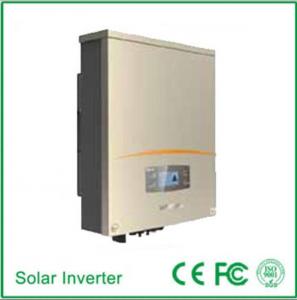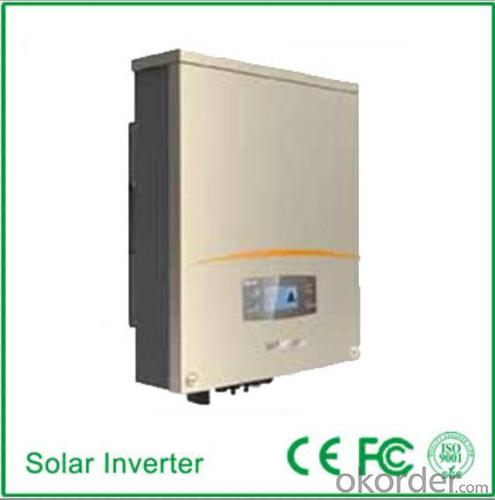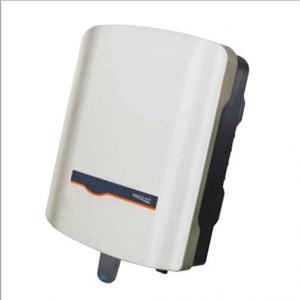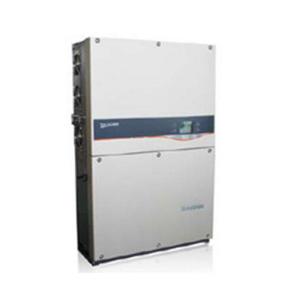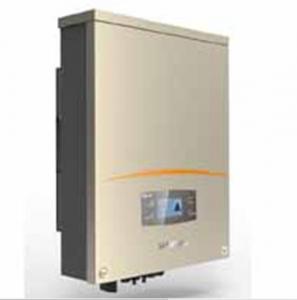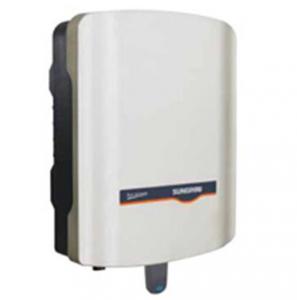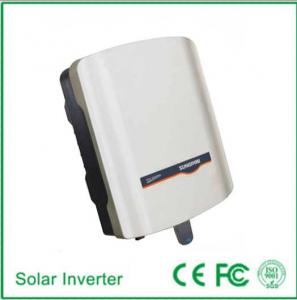Satcon Solar Inverter SG3KTL-EC
- Loading Port:
- China Main Port
- Payment Terms:
- TT or LC
- Min Order Qty:
- 50000 unit
- Supply Capability:
- 300000 unit/month
OKorder Service Pledge
OKorder Financial Service
You Might Also Like
1. Structure of Solar Photovoltaic Grid-Connected Inverter SG3KTL-EC Description
A solar inverter, or PV inverter, or Solar converter, converts the variable direct current (DC) output of a photovoltaic (PV) solar panel into a
utility frequency alternating current (AC) that can be fed into a commercial electrical grid or used by a local, off-grid electrical network. It is a
critical BOS–component in a photovoltaic system, allowing the use of ordinary AC-powered equipment. Solar inverters have special
functions adapted for use with photovoltaic arrays, including maximum power point tracking and anti-islanding protection.
2. Main Features of the Solar Photovoltaic Grid-Connected Inverter SG3KTL-EC
• Flexible design due to dual MPP tracking that is equipped to obtain full nominal power, 3-phase supply
• High energy yield due to maximum efficiency up to 98.1%
• Low noise levels and internal consumption due to natural cooling
• Integrated theft protection
• Access to Home WiFi system and enjoy cloud services via smart phones
• Integrated power management function, easy to receive the adjustable command from grid
• Extensive communication: RS-485, Ethernet, WLAN / WiFi, 4 digital inputs for ripple control receivers
• Product certification: TÜV, VDE 0126-1-1, EN 62109-1/-2, CE, G83/1, VDE-AR-N 4105
• Manufacturer certification: ISO 9001, ISO 14001, OHSAS 18000
3. Solar Photovoltaic Grid-Connected Inverter SG3KTL-EC Images
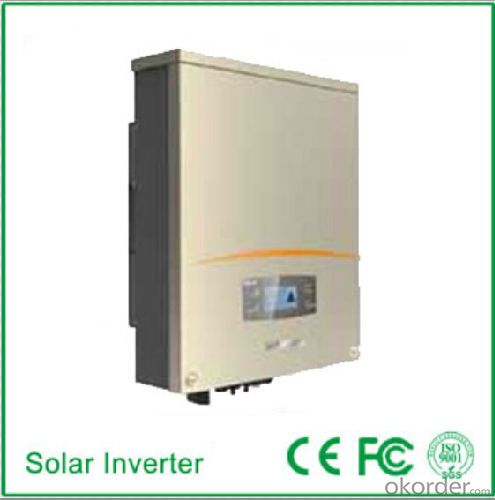
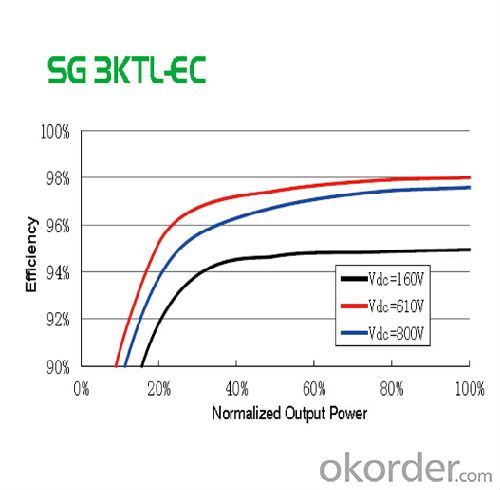

4. Solar Photovoltaic Grid-Connected Inverter SG3KTL-EC Specification
Input Side Data | |
Max. PV input power | 3191W |
Max. PV input voltage | 1000V |
Startup voltage | 200V |
Nominal input voltage | 610V |
MPP voltage range | 140~900V |
MPP voltage range for nominal power | 160~800V |
No. of MPPTs | 2 |
Max. number of PV strings per MPPT | 1/1 |
Max. PV input current | 19.8A(9.9A/9.9A) |
Max. current for input connector | 10A |
Short-circuit current of PV input | 24.8A(12.4A/12.4A) |
Output Side Data | |
Nominal AC output power | 3000W |
Max AC output power(PF=1) | 3000W |
Max. AC output apparent power | 3000VA |
Max. AC output current | 4.4A |
Nominal AC voltage | 3/N/PE,230/400Vac |
AC voltage range | 310~480Vac(May vary as per corresponding country's grid standard) |
Nominal grid frequency | 50Hz |
Grid frequency range | 45~55Hz |
THD | < 3 % (Nominal power) |
DC current injection | <0.5 %In |
Power factor | >0.99@default value at nominal power, |
Protection | |
Anti-islanding protection | Yes |
LVRT | No |
DC reverse connection protection | Yes |
AC short circuit protection | Yes |
Leakage current protection | Yes |
DC switch | Integrated |
DC fuse | No |
Overvoltage protection | III |
System Data | |
Max. efficiency | 98.0% |
Max. European efficiency | 96.0% |
Isolation method | Transformerless |
Ingress protection rating | IP65 |
Night power consumption | <1W |
Operating ambient temperature range | -25~60℃(>45℃ derating) |
Allowable relative humidity range | 0~100% |
Cooling method | Natural cooling |
Noise | ≤29dB |
Max. operating altitude | 2000m |
Display | Graphic LCD |
Communication | Ethernet,RS485(RJ45 connector), |
DC connection type | MC4 |
AC connection type | Plug and play connector |
Certification | VDE0126-1-1,EN62109-1,EN62109-2, |
Mechanical Data | |
Dimensions(W×H×D) | 403×518×190mm |
Mounting method | Wall bracket |
Weight | 22kg |
5. FAQ of Solar Photovoltaic Grid-Connected Inverter SG3KTL-EC
Q1. What is the difference between inverter and solar inverter?
A1. Inverter only has AC inpput, but solar inverter both connect to AC input and solar panel, it saves more power.
Q2. What is the difference between MPPT&PWM?
A2. MPPT has higher efficiency, it can track the max power point and won't waste energy.
- Q: How does a solar inverter handle voltage sags or swells in the grid?
- A solar inverter handles voltage sags or swells in the grid by continuously monitoring the voltage levels. When it detects a sag or swell, it adjusts its internal circuitry to regulate the output voltage accordingly. This ensures that the connected solar panels continue to operate within their optimal voltage range, minimizing any negative impact on the overall power generation system.
- Q: How does a solar inverter convert DC power to AC power?
- A solar inverter converts DC power to AC power by utilizing a two-step process. First, it converts the DC power generated by the solar panels into a high-frequency AC current. Then, it uses a transformer to increase the voltage and shape the AC waveform to match the grid's requirements. This process allows the solar energy to be fed into the electrical grid or used directly in homes and businesses.
- Q: How do you connect a solar inverter to the electrical grid?
- To connect a solar inverter to the electrical grid, you need to follow a few steps. Firstly, you need to ensure that your solar inverter is compatible with grid connection. Then, you'll need to install an AC disconnect switch and connect it to your main electrical panel. Next, connect the solar inverter output to the AC disconnect switch using appropriate wiring. Finally, hire a licensed electrician to inspect and connect the inverter to the utility meter or main electrical service panel, ensuring compliance with local regulations and safety standards.
- Q: Can a solar inverter be repaired or serviced?
- Yes, a solar inverter can be repaired or serviced. In case of a malfunction or damage, skilled technicians can diagnose and fix the issue, replace faulty components, or provide maintenance services to ensure optimal performance. It is recommended to consult with professionals or contact the manufacturer for assistance with repairs or servicing.
- Q: Can a solar inverter be used in regions with high altitude conditions?
- Yes, a solar inverter can be used in regions with high altitude conditions. However, it is important to consider certain factors such as temperature, air density, and potential voltage fluctuations that can affect the performance of the solar inverter at high altitudes. Specialized inverters or adjustments may be required to ensure optimal functioning in such conditions.
- Q: How does a solar inverter handle sudden changes in solar irradiance?
- A solar inverter handles sudden changes in solar irradiance by continuously monitoring the amount of solar energy being generated. When it detects a sudden change in solar irradiance, the inverter adjusts its internal settings accordingly to maintain a stable output voltage and frequency. This allows it to effectively handle fluctuations in solar power input and ensure a consistent and reliable flow of electricity to the connected loads or the grid.
- Q: Can a solar inverter be used with a solar-powered water purification system?
- Yes, a solar inverter can be used with a solar-powered water purification system. A solar inverter is responsible for converting the direct current (DC) electricity produced by solar panels into alternating current (AC) electricity that can be used to power various appliances and systems. In the case of a solar-powered water purification system, the solar inverter can convert the DC electricity generated by the solar panels into AC electricity, which can then be used to power the water purification system's pumps, filters, and other components. This allows the system to operate efficiently and effectively using renewable solar energy.
- Q: What are the potential risks of overcharging a battery connected to a solar inverter?
- Overcharging a battery connected to a solar inverter can lead to several potential risks. Firstly, it can cause damage to the battery itself, reducing its overall lifespan and efficiency. Additionally, overcharging can generate excessive heat, which can increase the risk of fire or explosion. Over time, repeated overcharging can also result in the release of toxic gases from the battery, posing health hazards. Finally, overcharging can destabilize the entire solar power system and damage the inverter, requiring costly repairs or replacements.
- Q: What is the difference between a PV inverter and a solar inverter?
- The main component of the inverter is the three-phase bridge converter. The main purpose of the grid-connected inverter is to change the power to DC and change the AC power. The main purpose is to improve the power quality (because the wind power generation is very large
- Q: How does a solar inverter monitor and optimize energy production?
- A solar inverter monitors and optimizes energy production by tracking the amount of solar energy being generated by the solar panels. It continuously adjusts the voltage and current to ensure the maximum power is being extracted from the panels. Additionally, it monitors the grid conditions and adjusts the output accordingly to ensure compatibility and stability. Through advanced algorithms and real-time data analysis, a solar inverter maximizes energy production by continuously adapting to the changing environmental and grid conditions.
Send your message to us
Satcon Solar Inverter SG3KTL-EC
- Loading Port:
- China Main Port
- Payment Terms:
- TT or LC
- Min Order Qty:
- 50000 unit
- Supply Capability:
- 300000 unit/month
OKorder Service Pledge
OKorder Financial Service
Similar products
Hot products
Hot Searches
Related keywords
